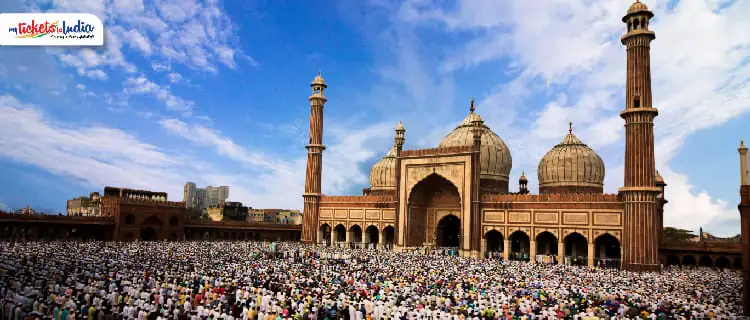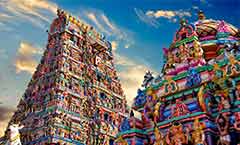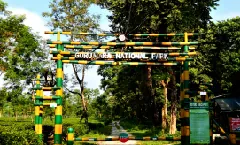Jama Masjid: Delhi’s Architectural Wonder

Posted on Tuesday, June 25th, 2024 by Sidakbir Singh
Jama Masjid, located in Old Delhi, is one of India’s largest mosques, built by Mughal Emperor Shah Jahan between 1650 and 1656. It can accommodate over 25,000 worshippers. The mosque features stunning Mughal architecture with red sandstone and white marble, three domes, and two minarets. Visitors can climb the southern minaret for scenic views of Old Delhi. It’s a rich center of faith and history.
| Aspect | Information |
| Name | Jama Masjid |
| Location | Delhi, India |
| Built By | Mughal Emperor Shah Jahan |
| Construction Period | 1644 – 1656 CE |
| Architectural Style | Mughal Architecture |
| Materials Used | Red sandstone, marble |
| Capacity | Over 25,000 worshippers |
| Minarets | Two minarets, each 40 meters tall |
| Domes | Three domes |
| Key Features | Grand entrance, large courtyard, intricate carvings, calligraphy, and marble inlays |
| Significance | One of the largest and most well-known mosques in India, an important place of worship and historical monument |
| Visiting Hours | Open daily from sunrise to sunset (Closed during prayer times for non-Muslims) |
| Entry Fee | Free entry for worshippers; a nominal fee for tourists (especially for photography) |
Jama Masjid History
Jama Masjid, formally known as Masjid-i-Jahan-Numa, stands as one of India’s largest and most impressive mosques. Jama Masjid was built by Mughal Emperor Shah Jahan, the same ruler who built the Taj Mahal and was constructed between 1650 and 1656.
Jama Masjid was not just a place of worship but also a symbol of Mughal power and architectural prowess. The mosque features a spacious courtyard that can hold up to 25,000 worshippers, three large gates, four towers, and two 40-meter-high minarets constructed of strips of red sandstone and white marble. The main prayer hall is adorned with intricate carvings and verses from the Quran.
How to Reach Jama Masjid
- By Bus:
-Take a DTC (Delhi Transport Corporation) bus towards Old Delhi or Chandni Chowk.
-Get off at the Jama Masjid stop. - By Flight:
-Fly to Indira Gandhi International Airport (DEL).
-Take the Airport Express Line to New Delhi Metro Station.
-Switch to the Yellow Line towards Chandni Chowk.
-Take a rickshaw or walk 15 minutes to Jama Masjid from Chandni Chowk Metro Station. - By Train:
-Arrive at Old Delhi Railway Station (Delhi Junction).
-Take an auto-rickshaw or cycle rickshaw directly to Jama Masjid (about 2 km).
-Alternatively, walk through Old Delhi’s streets to reach the mosque.
Best Time to Visit Jama Masjid
- Weather Considerations: The best time to visit Jama Masjid is during the cooler months from October to March when the weather in Delhi is pleasant.
- Avoiding Crowds: Early mornings and late afternoons are ideal to avoid large crowds and to experience the mosque in a more serene setting.
- Festivals and Events: Visiting during major Islamic festivals like Eid can offer a unique cultural experience, but expect larger crowds.
- Day of the Week: Weekdays are generally less crowded than weekends, providing a more relaxed visit.
Jama Masjid Timings
- Morning Timings: Jama Masjid opens early in the morning for Fajr prayers, usually around 5:00 AM.
- Visiting Hours: Tourists can visit from around 7:00 AM onwards after the early prayers.
- Afternoon Break: The mosque closes briefly after Dhuhr prayers, typically from 12:00 PM to 1:30 PM.
- Evening Timings: It remains open in the afternoon until late evening, closing around 6:30 PM after the evening prayers.
- Friday Timings: Special Jummah prayers are held around midday on Fridays, attracting larger crowds.
Tip: The Jama masjid entry fee is free and it is open to all visitors for worship and sightseeing.
Courtyard and Prayer Halls
The courtyard of Jama Masjid is expansive, accommodating up to 25,000 worshippers during Friday prayers. Surrounded by grand gates and paved with red sandstone, it provides a serene setting for communal worship. Flanked by three ornate prayer halls, adorned with intricate carvings and marble inlays, the courtyard serves as a central hub of spiritual and architectural significance in Old Delhi.
Surrounded by high walls and grand gates, the courtyard provides a peace yet imposing setting that contrasts with the bustling streets outside. It is made with red sandstone and meticulously laid out to create a harmonious pattern. The courtyard’s design allows large gatherings, allowing worshippers to spread out comfortably while maintaining a sense of unity and collective devotion.
Nearby Attractions in the Jama Masjid
- Red Fort: A historic Mughal fort in Old Delhi The Red Fort, is known for its massive walls and intricate architecture.
- Chandni Chowk: A bustling old market in Old Delhi, Chandni Chowk is famous for its street food and traditional goods.
- Raj Ghat (Mahatma Gandhi Memorial): A memorial for Mahatma Gandhi, Raj Ghat marking his cremation site with a black marble platform.
- India Gate: A 42-meter-tall war memorial India Gate in New Delhi, honoring soldiers of the British Indian Army from World War I.
- Humayun’s Tomb: The tomb of Mughal Emperor Humayun, Humayun’s Tomb is a UNESCO site and predecessor to the Taj Mahal.
- Qutub Minar: A 73-meter-tall minaret, part of the Qutub Minar complex, and the tallest brick minaret in the world.
- Lotus Temple: A Bahá’í House of Worship shaped like a lotus, Lotus Temple is open to people of all faiths for meditation.
- Akshardham Temple: Akshardham Temple is a large Hindu temple complex known for its stunning architecture and cultural exhibitions.
Jama Masjid Famous Food
The Jama Masjid area in Old Delhi is renowned for its delicious street food, especially around Chandni Chowk. Here are some famous foods you can enjoy:
- Parathas: Stuffed parathas with various fillings like potato, paneer, or mixed vegetables.
- Kebabs: Seekh kebabs, chicken tikka, and shami kebabs are popular choices.
- Nihari: A slow-cooked stew of meat, usually beef, with flavorful spices.
- Biryani: Fragrant rice cooked with marinated meat, often served with raita.
- Chaat: Spicy and tangy snacks like golgappas (pani puri), dahi bhalla, and papri chaat.
- Jalebi: Crispy and sweet spirals of deep-fried batter soaked in sugar syrup.
Visitor Guidelines and Pro Tips
- Carry a valid ID, check entry fees and timings online, and note any dress codes.
- Visit early morning or late afternoon to avoid crowds and heat.
- Wear comfortable shoes and light clothing.
- Carry water to stay hydrated.
- Beware of pickpockets in crowded areas.
- Consider hiring a guide for historical insights.
- Try local street food at hygienic spots.
- Check if photography is allowed; some sites may have restrictions.
- Use metro or app-based cabs for convenient travel.
- Book tickets online in advance to save time.
Other Activities To Do in Delhi
Tourism in Delhi offers a variety of experiences beyond its historical landmarks. Explore vibrant markets such as Sarojini Nagar and Dilli Haat for handicrafts and local goods. Enjoy a peaceful boat ride at India Gate or indulge in art and history at the National Museum. Experience Delhi’s dynamic nightlife in popular hubs like Connaught Place and Hauz Khas Village, known for their eclectic mix of restaurants, bars, and live music venues.
- Akshardham Swaminarayan Temple
- Jahanpanah
- Places To Visit In Delhi
- Purana Qila
- Kalka Mandir
- Connaught Place
- Gurudwara Bangla Sahib
- India Gate
- Jantar Mantar
- Sarojini Nagar Market
Other Popular Attractions in India
India is full of wonderful places to explore! Here are some of the best tourism in India options for you to have a look at!
Frequently Asked Questions
Q: Who built Jama masjid in Delhi?
A: Jama Masjid was built by Mughal Emperor Shah Jahan between 1650 and 1656.
Q: Where is Jama masjid located?
A: Jama Masjid is located in Old Delhi, specifically in the area known as Chandni Chowk, near the Red Fort.
Q: How many Jama masjid in India?
A: There are several Jama Masjids (Friday mosques) in India, with notable ones in Delhi, Ahmedabad, Mumbai, Hyderabad, Srinagar, and Fatehpur Sikri, serving as important centers of worship for local Muslim communities.
Q: How to reach jama masjid by metro?
A: To reach Jama Masjid by metro, take the Yellow Line (Line 2) to Chawri Bazar Metro Station. It is a 10-15 minute walk along Chandni Chowk Road to reach the mosque.
Q: Why is Jama Masjid Famous?
A: It is one of the largest and most iconic mosques in India, built by Mughal Emperor Shah Jahan. Known for its impressive Mughal architecture, featuring red sandstone and white marble, and capable of accommodating thousands of worshippers.
Q: Can hindu go to Jama masjid ?
A: Yes, Hindus can visit Jama Masjid as it is open to people of all faiths and serves as a historical and cultural landmark in Delhi.
Don’t stress about travel plans! MyTicketsToIndia is here to simplify your flights from USA to India and back. Reach out to our dedicated team now to secure your flights and enjoy a seamless travel experience.







